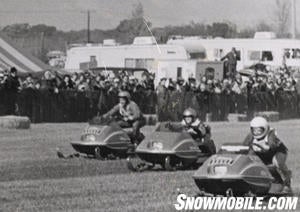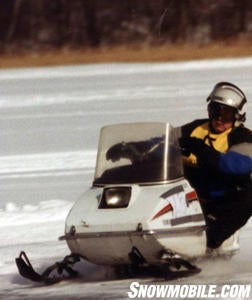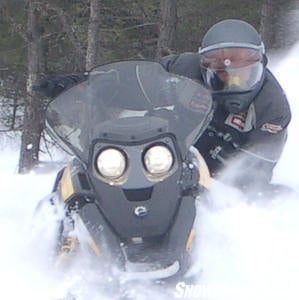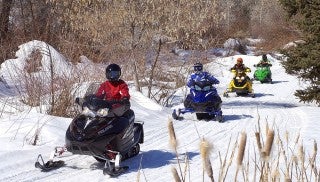Bassett’s Blog: Everyone’s the best rider

In ‘our day,’ we really were the best, and we had the race result to prove it
Every snowmobiler—to one degree or another—feels that he is the best snowmobiler ever. Ahh, c’mon, you know it’s true. Do you really hit the trails thinking: ‘Gosh, I’m the worst rider in the group’? Not bloody likely!
Trail riding may give us a chance to show our prowess with our buddies, but do you ever wonder how you might do against some serious competition—on a race track?
Every now and then we do. As humbling as it may be, it refreshes the ego—until the next time.
As a youth, my competitive urges were exorcised in small town competitions in my native New Hampshire. The events were low key and winners received little bowling-style trophies with snowmobiles instead of bowlers atop of them. Cash was always nice, but the $20 or $30 prizes would barely cover the costs of fuel for the pickup, the sled and food for the racer and whoever he managed to con into being his cheering section/pit crew.
 Flukes happen. Here Jerry Bassett’s Scorpion sneaks across the line for an unlikely victory.
Flukes happen. Here Jerry Bassett’s Scorpion sneaks across the line for an unlikely victory.The Winnipeg lesson
Later as a magazine writer, I managed to con Polaris into loaning me a sled to run in the Winnipeg-to-St. Paul endurance race. It was for a feature story, of course. It was a great experience that taught me the difference between factory-backed support and shoestring budget racing. When your shoestring budget racer gets passed by a factory rider, you need to hold on to the handlebars so you don’t get blown off the course. That event gave me a profound respect for long distance terrain racers, both factory riders and privateers. But my admiration is with the privateer who knows that he doesn’t really have a prayer of winning but nonetheless competes as hard as he can.
It seems like I’ve tried some form of racing every decade or so that I’ve been involved in the sport. There was the grass drag era with a Scorpion Range Whip. As with the Winnipeg race, I used my position as editor and the ploy of getting a first-hand story for a snowmobile magazine. After a bit of cajoling, Scorpion generously loaned me a sled to run in what was known as Trail Stock.
Talk about humbling, my first event was in southestern Wisconsin. This was a very competitive circuit. I usually made only one pass per event as I rarely got out of the qualifying rounds.
Despite the rider, the Range Whip seemed perfectly suited for this stock class. It came with a Para-Rail suspension and a grippy, polyurethane track. The suspension combined the rolling friction of a bogie wheel unit with the bump absorption of a parallel rail slide suspension. At the time, we figured the Range Whip would get a solid holeshot and be able to maintain traction.
The engine was a 399cc JLO-based air-cooled twin that Scorpion named Cuyuna, after the iron range region in Minnesota where the company was based. It was adequate in power and was the best choice for the 400 Trail Stock class. What we really liked at the time was the drive clutch—so easy to tune that even a magazine editor could do it! You simply added or subtracted washers to gain or reduce engine to clutch engagement.
 You can relive the ‘old days’ by competing in vintage events.
You can relive the ‘old days’ by competing in vintage events.Hay Day racing
The oddest result, though, was when we ran the sled at one of the earliest Hay Day events in Minnesota. It was the mid-1970s, and Hay Day had yet to become the big ‘start of winter’ event that it is now. It was actually more race than new product showcase back then. The drag strip was substantially longer than those we see today and instead of starting lights there was a flag man with a homemade flag. Spotters at the far end of the track determined your finish. Errors were common. But not in our case. We did actually win!
It was amazing. I was chatting with a staffer as our class was called to the line. We nearly missed the start entirely. Because the 400 Trail Stock class had single digit entries there were no qualifying runs. We went right to a final.
Before the event, we tried to establish a good holeshot strategy. We had called a friend at Scorpion who suggested we clutch for a long track in lieu of a quick hole shot. Our final clutching for the sled was a best estimate finessed on the side lawn of my house just the day before.
At the track we fired up the motor. The single float-type Walbro carburetor seemed to flow fuel well enough to the Cuyuna twin. We made a practice run or two to get ready for the start. Then we simply parked the sled, waiting for our turn to run for real.
The final
As mentioned, we nearly missed the call to the line. We were so hurried and frantic to get to the start we didn’t have time to be nervous. In our previous runs in Wisconsin, we never got out of the qualifiers to advance. It was good that there was only a final.
 We all like to be the ‘best’ rider and the get most from ourselves and our rides.
We all like to be the ‘best’ rider and the get most from ourselves and our rides.We just got up to the line when the starter raised the flag. Everyone was off. We were late on the trigger. And our clutching was off. We slogged away as the engine bogged slightly. Then it revved up and settled in to pull the clutching up to its peak. We started to gain ground, slowly at first and then more quickly. The leaders had jumped away fast but seemed to have peaked out as we continued building speed and zeroing in on the finish. It was close. Close enough to thoroughly annoy the second place guy who tried to protest us later. But, we won!
Later, because we were the winner, we had to tear down the engine for inspection. We had a young fellow along who managed to get us through that. But after the inspection, a race official pulled us over, shaking his head, he smiled and told us he couldn’t believe our sled could have won anything. He said the engine was pitted with red iron dust from the Cuyuna range. The sled Scorpion loaned us had been plucked out of the company’s endurance test fleet. Those sleds, including ours, were run for miles in the dirt and dust where the engines sucked in red iron ore along with air and fuel. If the second place guy had known that, he would have been even more discouraged losing to us!
After that, we retired from grass drags. But to this day, we continue looking for ways to challenge ourselves and to show that even with age we still have a semblance of remaining a good rider. There’s always a chance for our ego to be placated as it was once on a ride in the Yukon when a local sledder told us that we must have been a “heck of a rider in our day!” Like all snowmobilers, we don’t really want ‘our day’ to pass without a fight—or, at the very least, a really quick ride!








 Your Privacy Choices
Your Privacy Choices